
To be celebrated on 10th April 2022
Palm/ Passion Sunday
Processional Gospel Reading: Luke 19:28-40
vs. 28 Jesus went on ahead, going up to Jerusalem.
vs. 29 Now when he was near Bethphage, close by the Mount of Olives, as it is called, he sent two of the disciples, telling them,
vs. 30 “Go off to the village opposite, and as you enter it you will find a tethered colt that no one has yet ridden. Untie it and bring it here.
vs. 31 If anyone asks you, ‘Why are you untying it?’ you are to say this, ‘The Master needs it.'”
vs. 32 The messengers went off and found everything just as he had told them.
vs. 33 As they were untying the colt, its owner said, “Why are you untying that colt?”
vs. 34 and they answered, “The Master needs it.”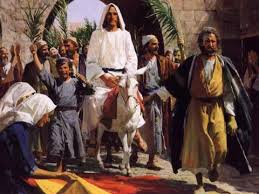
vs. 35 So they took the colt to Jesus, and throwing their garments over its back, they helped Jesus onto it.
vs. 36 As he moved off, people spread their cloaks in the road, and now, as he was approaching the downward slope of the Mount of Olives,
vs. 37 the whole group of disciples joyfully began to praise God at the top of their voices for all the miracles they had seen.
vs. 38 They cried out: “Blessings on the King who comes, in the name of the Lord!
Peace in heaven and glory in the highest heavens!”
vs. 39 Some Pharisees in the crowd said to him,
“Master, check your disciples,”
vs. 40 but he answered, “I tell you, if these keep silence the stones will cry out.”
**************************************************
We have four commentators available from whom you may wish to choose .
Michel DeVerteuil : A Trinidadian Holy Ghost Priest, director of the Centre of Biblical renewal .
Thomas O’Loughlin: Professor of Historical Theology, University of Wales, Lampeter.
Sean Goan: Studied scripture in Rome, Jerusalem and Chicago and teaches at Blackrock College and works with Le Chéile
Donal Neary SJ: Editor of The Sacred Heart Messenger
**********************************
Michel de Verteuil
Lectio Divina The Year of Luke
www.columba.ie
General Comments
The Palm Sunday procession is a living lesson in liturgy. By inviting us to imitate the actions of Jesus entering Jerusalem and the crowd welcoming him, the Church wants us to experience that the story is still being lived today. Whenever people of faith decide to confront evil at its source, and do so with inner freedom, remaining faithful to their values, Jesus is once more entering Jerusalem.
We can have the same experience by meditating on the gospel texts and recognizing ourselves in them.
Each of the gospels tells the story of Jesus’ entry into Jerusalem in a distinctive way. In St Luke’s account, which we read this year, there is first of all the very significant verse 28, which describes Jesus “going on ahead of his disciples.”
The events described in verses 29 to 34 are found in all the synoptic accounts, a sign that the early Church found them highly symbolical. Some take the story as evidence of Jesus’ supernatural powers, but it could merely be evidence of his self-confidence as he faces his great moment of truth, a mark of true leadership.
In St Luke’s account, it is the disciples themselves, entering alongside Jesus, who are moved to excitement at this moment.
A small detail, but clearly significant for St Luke: the disciples “helped Jesus on to the colt.”
The people do not wave palm branches in St Luke’s account, but their gesture of spreading their cloaks in the road before Jesus is both a sign of their wild excitement and their welcoming him as a king.
The cry of the people in verse 38 echoes the song of the angels at the birth of Jesus (Luke 2:14).
The brief dialogue in verses 39-40 can be interpreted in different ways. The Pharisees in question may have been followers of Jesus who were afraid of confrontation and wanted to protect Jesus. Or they may have represented the first assault of the opposition to Jesus. In either case his answer expresses his inner freedom very dramatically.
Scripture reflection
Lord, there comes a time in the lives of all of us when we, like Jesus,
must enter into a radical confrontation:
– those in authority have been abusing their power;
– we finally recognise that we need help to overcome an addiction;
– some members of our community have betrayed the cause and must be excluded;
– we need to give up our comfortable situation and move into something new.
 At these moments, give us
At these moments, give us
– and especially those of us whom you have called to be leaders in our communities
– a share in the inner freedom of Jesus,
so that like him we can go on ahead of the rest, as we go up to our Jerusalem.
Help us like Jesus to make our arrangements confident that they will come to pass,
and to allow ourselves to be put in a position of authority.
Help us to be so confident of our cause
that if someone told us to check our followers
we would know that if they kept silence, the stones would cry out.
Lord, we thank you for glorious moments of grace
– we found a friend whom we felt we could trust perfectly;
– we enjoyed intimacy with our spouse;
– one of our children did us proud;
– a new social movement arose in our country.
We were like the disciples when Jesus approached the downward slope of the Mount of Olives: we joyfully began to praise you at the top of our voices for the miracle which we had seen.
We cried out, ”Blessings on the king who comes in the name of the Lord!”
We glorified you in the highest heavens.
Lord, it is strange how when the moment of grace comes,
everything seems to fall into place very naturally.
If we need something, we find as the disciples did on the first Palm Sunday,
that all we need say is, “The Master needs it,” and immediately all obstacles are removed.
Lord, we pray that as a Church we may not betray our young people.
Often we lack the courage of our convictions, are too anxious to please them, and do not go ahead of them.
But when young people today meet leaders who challenge them, they joyfully praise God, they are ready to spread their cloaks in the road before them,
and welcome them as kings who come in the name of the Lord.
“The important events of history are the thousands of humble actions that heal and reconcile.” … Cardinal Arms of Sao Paulo in Brazil, 1994
Lord, we thank you for the many humble people who enter Jerusalem in peace.
As we think of them, we praise you at the top of our voices and cry out,
“Peace in heaven and glory in the highest heavens.”
************************************************
Thomas O’Loughlin,
Liturgical Resources for the Year of Luke
www.Columba.ie
Introduction to the Celebration
The text in the Missal (p. 123: ‘Dear friends in Christ …‘) cannot be bettered. However, care should be taken to read it as if it were one’s own notes so as to stress the notion that we are entering into the Great Week, accompanying Christ in the Paschal Mystery.
Passion Notes
1. For those who seeking in the gospels an historical record of the events of Jesus’ life, the passion accounts present an awful problem: for the most crucial event in the whole story the early churches had at least four different pictures. When Christians today think of Jesus’s death their picture is invariably a mixture with the people drawn from John and the general scene from the synoptics. 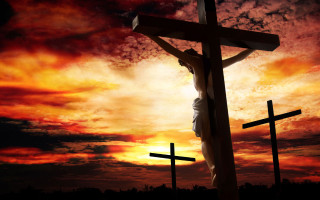 Christ is flanked by two other crosses (Jn 19:18; but a detail common to all four), and standing near him are ‘his mother, and his mother’s sister, Mary the wife of Clopas, and Mary Magdalene’ and John (Jn 19:25-26). Nearby also are soldiers casting lots for his clothes (Jn 19:23-25 but with parallels in all four). The scene is one of darkness covering the earth (Mt 27:45; Mk 15:33; Lk 23:44 — a darkness unknown in Jn). Against this conflation, it is worth noting how Luke sets out his scene as it allows us to see his particular perception. The scene of the crucifixion is dark (Lk 23:44) not only in terms of light, but in terms of the courage of his followers: those who knew him, men and women who had followed him from Galilee stood at a distance watching the event unfold (Lk 23:49). Near him there are a crowd of spectacle lovers, scoffing leaders and mocking soldiers (Lk 23:35-36). In Matthew and Mark both criminals also taunt him (they are silent in John), but in Luke (23:39-43) we have the dialogue of the Good Thief whose opening words are a confession that Jesus is suffering as an innocent man (23:41). The centurion’s confession is found only in Mark (15:39) and Luke (23:47), but while in Mark this is a christological statement, in Luke it is a declaration of the imiocent suffering of Jesus: ‘Now when the centurion saw what had taken place, he praised God, and said, “Certainly this man was innocent!”.’ Luke, uniquely, adds another detail at this point: ‘And all … who assembled to see the sight, when they saw what had taken place, returned home beating their breasts’(23:48).
Christ is flanked by two other crosses (Jn 19:18; but a detail common to all four), and standing near him are ‘his mother, and his mother’s sister, Mary the wife of Clopas, and Mary Magdalene’ and John (Jn 19:25-26). Nearby also are soldiers casting lots for his clothes (Jn 19:23-25 but with parallels in all four). The scene is one of darkness covering the earth (Mt 27:45; Mk 15:33; Lk 23:44 — a darkness unknown in Jn). Against this conflation, it is worth noting how Luke sets out his scene as it allows us to see his particular perception. The scene of the crucifixion is dark (Lk 23:44) not only in terms of light, but in terms of the courage of his followers: those who knew him, men and women who had followed him from Galilee stood at a distance watching the event unfold (Lk 23:49). Near him there are a crowd of spectacle lovers, scoffing leaders and mocking soldiers (Lk 23:35-36). In Matthew and Mark both criminals also taunt him (they are silent in John), but in Luke (23:39-43) we have the dialogue of the Good Thief whose opening words are a confession that Jesus is suffering as an innocent man (23:41). The centurion’s confession is found only in Mark (15:39) and Luke (23:47), but while in Mark this is a christological statement, in Luke it is a declaration of the imiocent suffering of Jesus: ‘Now when the centurion saw what had taken place, he praised God, and said, “Certainly this man was innocent!”.’ Luke, uniquely, adds another detail at this point: ‘And all … who assembled to see the sight, when they saw what had taken place, returned home beating their breasts’(23:48).
2. A convenient way to see how Luke’s passion differs from the other is to note those items which are proper to him. These present Christ as the righteous one who is faithful to the end alone. Luke presents Jesus as alone from all those whom he had spent time with, eaten with, and been with in the good times; yet in the dark hour his goodness still shone out and transformed people. While his long-term followers were lying low, Jesus was gathering new witnesses to his truth amidst the moral chaos which was his crucifixion. The sense of finality is heightened at the beginning of the passage when Christ states his longing to eat the meal (the final meal in a whole series of meals in Luke) and that he shall not drink wine again until the kingdom comes (22:15- 20). It is also seen in his instructions for the church after his departure (22:35-7) and his warning to Jerusalem (23:27-32). His aloneness is pointed out in the prophesy that the disciples will desert him (22:21-3 and 33-4), and this is fulfilled in the detailed story of the triple denial of Peter (22:54-62)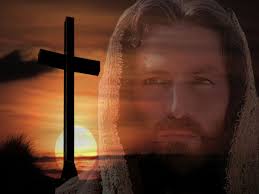
By this time Luke presents all the disciples as having fled. By the time of the crucifixion — in stark contrast to John from whence comes our familiar picture of John, Mary, and the other women standing beneath the Cross — there is not a single friendly face nearby: his acquaintances (hoi gnóstoi) and the women stand watching at a distance (23:49). In the end the only ones who acknowledge him are outsiders who at least recognise him as a good and righteous man: Pilate, a criminal, and Roman soldier. Luke alone has Pilate recognise him as one without fault (23:5; 14-5; and 22); similarly he alone has ‘the good thief’ incident who states that this man has done nothing wrong (23:39-43); and finally the centurion, but while in Mark 15:39 and Matthew 27:54 he states, ‘Truly this was the Son of God!’, here Luke has him state simply: ‘Certainly this man was righteous (dikaios).’
For Luke Christ in his passion is utterly abandoned, and he in turn abandons himself to the Father to do the Father’s will (22:22, 29, 37, 42-3). This abandonment reaches its climax in the final cry from the Cross (23:46).
Homily Notes
1. The Missal says that ‘a brief homily may be given.’ There is definitely a case today for taking up this permission to omit the homily altogether; not because such an omission might shorten an already long liturgy, but since we have just come through one of the longest verbal elements in the whole of the liturgy (the passion), another verbal event (a homily) does not bring contrast or help the gospel reading to sink in. A better way to highlight what has been read would be a couple of moments of structured silence (e.g. ‘Let us now reflect in silence on the passion of our Saviour’) before standing for the Creed. On the subject of the length of today’s liturgy we should remember that length of time is one of the key non-verbal ritual cues that humans use to indicate special importance: a crucial symbolic event that is over in a moment, or takes just the same length of time as an ordinary event is an anti-climax – do not forget that Christmas dinner must take longer than an everyday meal. Because this is a special day opening a special week, it should md must take a noticeably longer time than an ordinary Sunday.
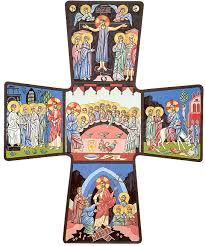 2. If one does preach, then the brief comments should be directed introducing the week as a whole rather than particular comments on the readings. This could take its starting point from the gospel outside – that Christ has arrived at, and entered Jerusalem, and that ‘his hour’ has arrived. As Christians we are sharers in this event.
2. If one does preach, then the brief comments should be directed introducing the week as a whole rather than particular comments on the readings. This could take its starting point from the gospel outside – that Christ has arrived at, and entered Jerusalem, and that ‘his hour’ has arrived. As Christians we are sharers in this event.
3. If the situation calls for a meditation rather than a homily, then a suitable meditation is provided in the Christ-hymn (the second reading) as a way of interpreting the events narrated. However, rather than re-reading it directly from the lectionary it may be broken up into its verses and read with pauses. The version used in the Office is better for such use than either the RSV/ JB. Better still, have it sung by a soloist and simply introduce as the earliest Christian meditation we possess on what we lve just recal1ed about the death of Jesus.
******************************************************
3. Sean Goan
Let the reader understand
www.columba.ie
Gospel: Luke 22:14-23:56
Holy week begins with a dual focus, namely the events of Palm Sunday and the triumphant march of Jesus into Jerusalem and then, by contrast, the story of his passion and death. In year C we read from Luke’s account of the passion and it is worth our while noting the differences, as each evangelist highlights different things in order to bring out the meaning of what is taking place. As in the public ministry of Jesus, so too in his death Luke stresses the themes of forgiveness and prayer. Only in Luke does Jesus pray that his executioners be forgiven and only here is the good thief mentioned. Also in Luke, Jesus dies with a prayer of trust on his lips, thus embodying a teaching that he had given many times in his life.
Reflection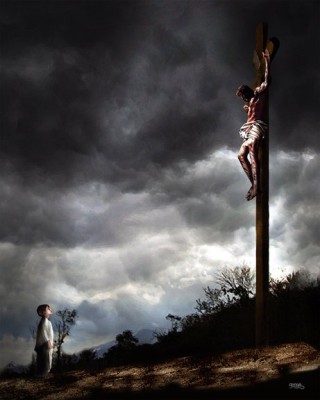
Suffering is part and parcel of being human and while we must readily acknowledge this fact it is also true that we usually do all in our power to avoid it. The readings for today are an invitation to reflect on how the passion of Jesus can change our outlook on suffering. Our Saviour may be seen in these texts as a model of patient endurance and of faithfulness. We are not asked to believe that suffering is good in itself but to see that good can come of it and to recognise in Jesus God’s solidarity with all those who endure suffering for doing what is right.
**********************************************
4. Donal Neary S.J.
Gospel reflections
www.messenger.ie/bookshop/
PALM SUNDAY
Who was there at the end?
Who was there at the end? The friends of Jesus: from a distance, but still around. They stayed near, not wanting to leave. Did they all stand around for a while? Wanting to go and not wanting to go, like mourners at a graveside – confused, sad and discouraged – silent in the moments of violent death. Were they afraid that this might happen to them too? The friends and acquaintances of Jesus, the one who promised much and said he would rise again… Did any of them remember this promise? Did they whisper it to each other as they closed the stone at the tomb? Did they wonder if more was yet to come? For there was always more with Jesus. We are that ‘more!
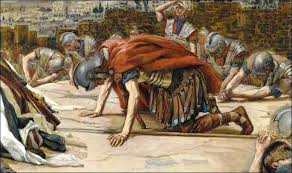
There also was the centurion: the good man who said, ‘he was a Son of God’. The one from Rome saw through the many from Jerusalem. He was a strange type of guy at the cross – the Roman who had been told to get these crucifixions done, with the least amount of trouble and publicity. Away from home and his own people, he would find a new God in the home of his heart and would be linked forever to a new people.
Something about this man gave a scent of love, and an authority that came from somewhere far away – further than an emperor or a political power. He knew that this man was a Son of God; may we know this too of Jesus.
Lord, by your cross and resurrection, you have set us free.
You are the saviour of the world.
___________________________________